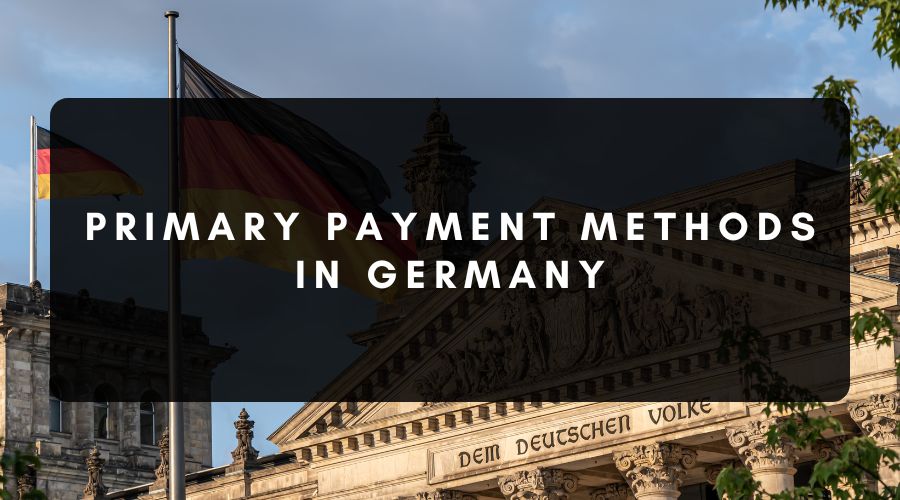
Main Payment Methods in Germany
Germany’s payment culture is a vivid blend of traditional payment methods like cash and innovative electronic and mobile payment solutions. This country began as a commerce hub due to its prominent location in Europe. The physical and electronic commerce scenes in Germany have since blossomed into a mix of tradition and modern convenience.
Cash is a popular payment method for German nationals. However, mobile payments and other contactless payment options have gained traction in recent years. Merchants who sell to German customers should offer their preferred payment methods to maximise in-person and online sales.
1. Debit Cards (Girocards)
Girocards are a kind of debit card issued by banks and savings banks in Germany—generally when a patron opens an account. Girocards are used for in-person card payments in Germany, especially at restaurants, shops, and supermarkets. Upon completing the transaction, the cardholder’s account is immediately debited and the account balance is updated in real time.
2. Credit Card Payments
Many Germans prefer cash and debit cards to credit card payments, and use credit cards less than people in many other European countries. However, the use of credit cards is becoming more popular. Young people and travellers often use these cards for convenience.
Visa, Mastercard, and American Express can be used at hotels, larger stores, and for online shopping. Be sure to check if small stores accept payments made with credit cards. Entrepreneurs looking to start an e-commerce business in Germany will need a merchant services account and global payment gateway to accept credit card payments.
3. Mobile Payments
Mobile payments are becoming a more popular and widely accepted payment method in Germany, especially in urban areas. A mobile payment can be made using a smartphone or smartwatch that is linked to either a bank account or payment card. Mobile payments are a great option for customers who would rather not carry a wallet or cash.
4. Bank Transfers (SEPA)
Bank transfers are a popular payment method in Germany. The Single Euro Payments Area (SEPA) facilitates secure and convenient bank transfers inside the EU. SEPA allows customers to make smooth cross-border euro transfers with minimal to no fees. Some international payment processors can also process these transfers on behalf of merchants for convenience.
Recurring payments for rent, utility bills, and subscriptions are a popular reason for using SEPA payments, making them an excellent option for businesses that work on a membership or subscription model. SEPA transfers take between 1-3 days to process, so prepare in advance.
5. Direct Debit
Direct debit, or Lastschrift, allows companies to withdraw money from German customers’ bank accounts automatically to pay for recurring or ongoing services.
Direct debit is a great solution for recurring payments such as:
- Gym memberships
- Children’s sports fees
- Utility bills
- Insurance
- Other memberships and subscriptions
This option is great for customers who want to avoid fees for late payments. Setting up recurring payments with direct debit services helps to solve that problem.
6. Cash
Cash was used for 40% of point-of-sale transactions in Germany in 2022. This shows that Germans value the option of paying in cash alongside electronic and digital payment methods.
Some restaurants, bakeries, and other small stores have a cash-only payment policy. If you need to get euros quickly, there are ATMs located throughout the towns for easy access. You will often find ATMs at train stations, banks, and shopping centres.
7. Prepaid Cards
Prepaid cards are a popular cashless payment method for in-person and online purchases in Germany. Cardholders simply load a specific amount of money on the card, then use the card in the same way as credit or debit cards.
This helps customers steer clear of debt because once the card is empty, it can’t be used again until more cash is put into the card. They are also popular as a kind of “universal gift card.”
8. Contactless Card Payments
Near-field technology (NFT) enables German customers to make contactless payments using cards or mobile devices. Contactless transactions are capped at 50 euros for security purposes and a PIN must be entered for larger transactions.
9. Invoices (Rechnung)
Paying by invoice is fairly common in Germany, and is one of the most popular online payment methods as it gives buyers a chance to inspect goods before paying. After the goods or services are received, the seller sends an invoice to the buyer. This invoice will have a payment deadline that typically falls between 7 to 30 days from the time of order.
Invoicing is a popular and trusted payment method in the German market. However, be warned that missing a deadline can result in fees and even legal action.
10. Buy Now Pay Later
Buy now pay later (BNPL) is a common online payment method in Germany. The popular Swedish fintech company Klarna and other BNPL providers allow customers to receive their purchases now and pay for them later. Young Germans especially love this feature for more flexibility when shopping online.
Cater to the Top Payment Methods in Germany
Popular payment methods in Germany range from cash-only to girocard, credit cards, mobile payments, SEPA transfers, direct debit, invoices, and BNPL. Digital payment methods are increasingly common in urban areas.
Merchants who sell to German customers must accept their preferred payment methods to boost sales and encourage repeat business. An international payment service provider with a global payment gateway that is optimised for e-commerce in Germany puts these customers’ preferred payment methods within your reach.

